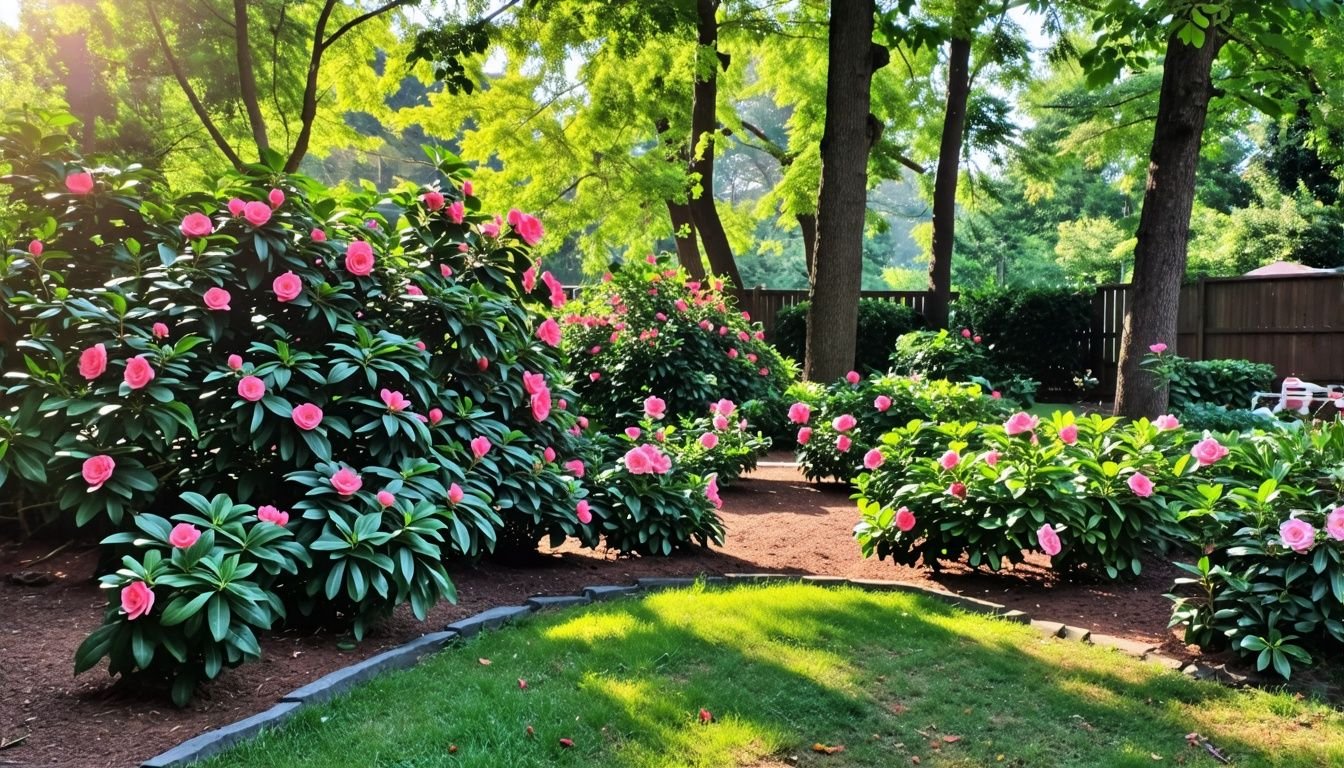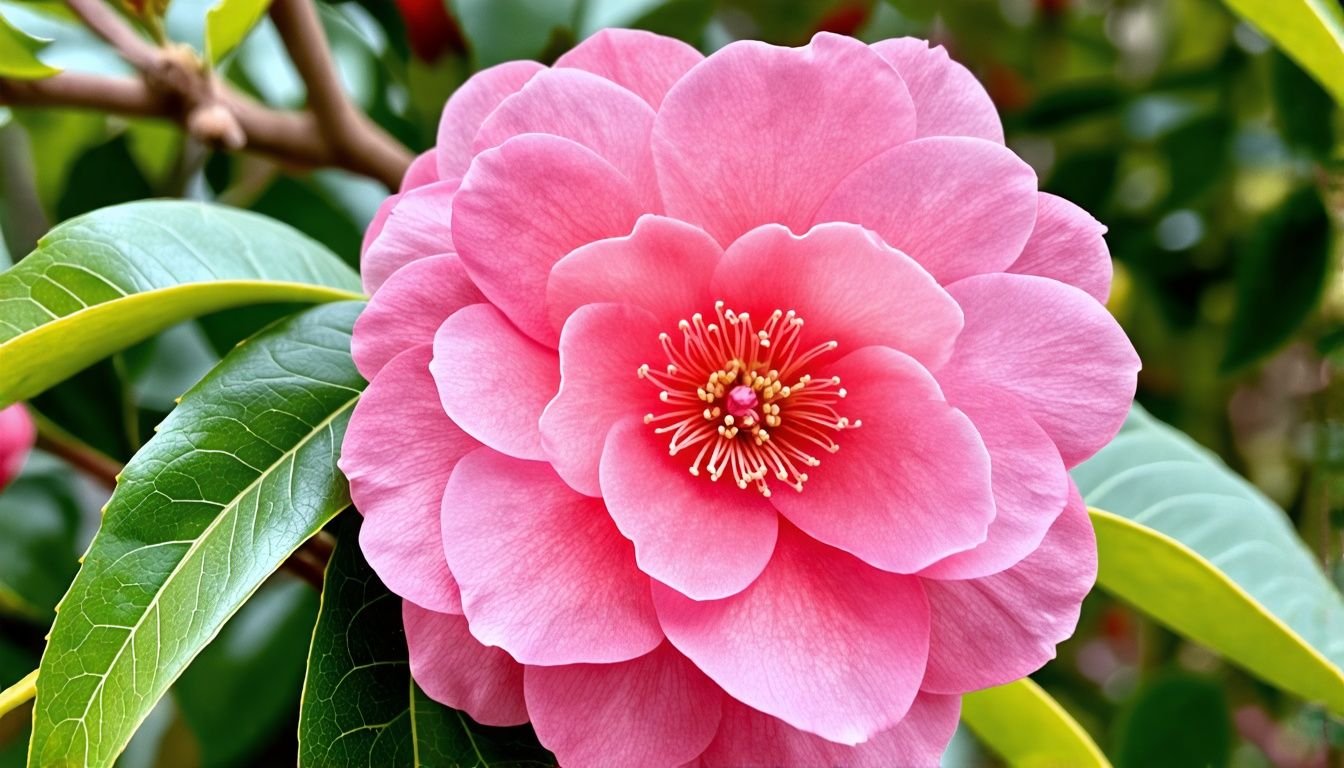G’day, fellow garden enthusiasts! We Aussies sure do love our green spaces, but let’s be honest – growing Camellia Chansonette can be a bit of a challenge. Many of us have scratched our heads over this beauty, not quite sure how to make it happy in our diverse climate.
From finding the perfect spot to dealing with those pesky pests, it can feel like an uphill battle.
But don’t chuck in the towel just yet! Our team’s been hard at it for years, researching and testing ways to grow Camellia Chansonette in Aussie gardens. Did you know this little ripper can grow up to 3 metres tall? Strewth! We’ve cracked the code on helping this stunning shrub thrive in our unique conditions.
So, grab a cuppa and settle in. Our guide will walk you through every step of growing and caring for Camellia Chansonette. We’ll cover everything from prepping your soil to mastering those pruning techniques.
Before you know it, your garden will be bursting with these gorgeous pink blooms. Fair dinkum!
Key Takeaways
- Camellia Chansonette grows up to 3 metres tall and thrives in a mix of sun and shade, needing shelter from strong winds and harsh sunlight.
- Plant Camellia Chansonette in autumn or early spring, ideally from mid-March to May, in free-draining soil rich in organic matter with a neutral to slightly acidic pH.
- Prune lightly every couple of years after flowering, removing dead or crossing branches and shaping the plant to maintain density and form.
- Watch for pests like white or brown scale, aphids, caterpillars, and red spider mites, using targeted sprays when needed to protect the plant.
- Camellia Chansonette works well as a hedge, feature plant, or in containers, and pairs nicely with other camellias, gladioli, and gardenias for a stunning garden display.
Optimal Planting Conditions for Camellia Chansonette
 Camellia Chansonette thrives in specific conditions. We’ll explore the best spots and soil types for this lovely plant.
Camellia Chansonette thrives in specific conditions. We’ll explore the best spots and soil types for this lovely plant.
Sun exposure and shade requirements
Camellia Chansonette thrives in a mix of sun and shade. We’ve found that these lovely plants do best with morning or afternoon sun. They need shelter from strong winds and harsh sunlight.
A spot with dappled shade works well for these beauties.
In most Aussie gardens, we aim for a balance. Too much direct sun can scorch the leaves, while too little light reduces flowering. We protect our Camellias from the hot afternoon rays, especially in summer.
This helps keep their dense foliage lush and green.
The right light makes all the difference for Camellia Chansonette.
Soil type and preparation play a big role in how well these plants grow. Let’s look at what kind of earth these beauties prefer and how to get it ready for planting.
Soil type and preparation
We’ve found that Camellia Chansonette thrives in free-draining soil rich in organic matter. Our gardens benefit from a mix that’s both neutral and slightly acidic. We always start by testing the soil pH and adjusting it if needed.
Then, we dig in plenty of well-rotted animal manure, leaf mulch, or compost. This gives our camellias the nutrient-packed foundation they crave.
For potted Chansonettes, we use a special potting mix loaded with humus. This ensures good drainage while holding just enough moisture. We’ve learned that poor drainage leads to root rot, so we’re careful to create the right balance.
Sometimes, we add extra perlite or coarse sand to improve drainage in heavy soils. This step is crucial for healthy growth and stunning blooms.
Planting and Initial Care
We plant Camellia Chansonette in autumn or early spring. This timing gives the roots time to settle before extreme weather hits.
Best season for planting
Autumn and early winter offer the perfect time to plant Camellia Chansonette in Australian gardens. These cooler months allow the plant to establish strong roots before the heat of summer arrives.
We’ve found that planting during this period gives the camellia a head start, helping it thrive in its new home.
Our experience shows that mid-March to May is ideal for planting this lovely shrub. The soil remains warm from summer, yet the air cools down, creating optimal conditions for root growth.
We always advise gardeners to check local nurseries for availability, as stock can vary depending on the season.
Initial watering and feeding
We’ll start our Camellia Chansonette’s journey with proper watering and feeding. Right after planting, we give our new shrub a good, deep drink. This helps settle the soil and removes air pockets around the roots.
We aim to keep the soil moist but not waterlogged in the first few weeks.
For feeding, we hold off on fertiliser at first. Our Camellia needs time to settle into its new home before we add extra nutrients. Once it shows signs of new growth, usually after a month or so, we can start with a light feed.
We use a slow-release fertiliser made for acid-loving plants. This gives our Camellia a gentle boost without overwhelming its system.
Regular mulching plays a big role in our Camellia’s care. We apply a layer of organic mulch around the base, keeping it away from the stem. This helps retain moisture and slowly feeds the soil as it breaks down.
As the seasons change, we’ll adjust our care routine to match our Camellia’s needs. Next, let’s look at the ongoing maintenance that keeps our Camellia Chansonette thriving year after year.
Ongoing Maintenance and Care
Caring for your Camellia Chansonette doesn’t stop after planting. Regular upkeep keeps your plant healthy and blooming. We’ll show you how to prune, feed, and protect your camellia from pests and diseases.
Pruning techniques
We prune our Camellia Chansonette to keep it healthy and shapely. Light pruning every couple of years helps maintain density and form. After flowering, we trim the plant to our desired shape.
This timing is crucial as it allows new growth to develop before the next blooming season. We use clean, sharp tools to make neat cuts just above a leaf node. This method encourages bushy growth and prevents disease spread.
Our pruning approach focuses on removing dead, damaged, or crossing branches first. We then shape the plant by cutting back longer stems to create a balanced look. For hedges, we trim the top and sides evenly.
Single specimen plants may need less frequent pruning. We always step back often to check our work and ensure we’re not over-pruning. This careful technique keeps our Camellia Chansonette looking its best year-round.
Managing pests and diseases
Pests and diseases can threaten our beloved Camellia Chansonette. We keep a watchful eye for white or brown scale, aphids, caterpillars, and red spider mites. These critters love to munch on our plants.
To protect our camellias, we use targeted sprays when needed. This helps us maintain healthy, vibrant plants in our Australian gardens.
A healthy garden starts with vigilant pest management.
Our approach to pest control is balanced. We aim to use the least harmful methods first. Sometimes, a strong spray of water can dislodge pests. Other times, we might need to apply horticultural oils or insecticidal soaps.
We always follow product instructions carefully. This way, we keep our Camellia Chansonette looking its best while being kind to the environment.
Enhancing Garden Aesthetics with Camellia Chansonette
Camellia Chansonette can transform your garden into a stunning oasis. We love pairing this beauty with other plants that complement its delicate pink blooms and glossy leaves.
Companion planting options
We love pairing Camellia Chansonette with other plants to create stunning garden displays. Camellia Brushfield Yellow, Camellia Mignonne, and Camellia Nuccios Pearl make excellent companions.
These varieties offer a mix of colours and bloom times, extending the visual appeal of your garden.
For added flair, we suggest planting Gladiolus Cantate and Gardenia Professor Pucci nearby. The tall, colourful spikes of gladioli contrast beautifully with the low-growing Chansonette.
Gardenias contribute their sweet scent, making your garden a treat for both eyes and nose.
We find that mixing different textures and heights creates depth in the garden. Try pairing Chansonette with ornamental grasses or small shrubs. This approach adds interest and helps showcase the Chansonette’s lovely pink blooms.
It’s beneficial to consider each plant’s sun and soil needs when planning your garden layout.
Using as a hedge or feature plant
Camellia Chansonette shines as a hedge or feature plant in Aussie gardens. We often use this beauty to create stunning flowering hedges that offer privacy and visual appeal. Its compact growth habit makes it perfect for shaping into neat borders or screens.
As a feature plant, Camellia Chansonette stands out with its abundant pink blooms against glossy green leaves.
For those keen on container gardening, this versatile shrub thrives in large pots. We’ve seen it work wonders in courtyard settings or on patios. Its ability to grow well in tubs opens up options for small-space gardeners too.
Whether as a hedge or standalone feature, Camellia Chansonette adds charm and colour to any Aussie outdoor area.
Conclusion
We’ve provided our advice on cultivating Camellia Chansonette in Australian gardens. This charming plant adds beauty and elegance to any outdoor area. With the right care, it will flourish and flower year after year.
Ensure it has suitable soil, sunlight, and water. Lightly prune it after flowering to maintain its shape. Your efforts will be rewarded with a gorgeous display of pink blooms each winter.
FAQs
1. How does Camellia Sasanqua ‘Chansonette’ adapt to Australian climates?
Camellia Sasanqua ‘Chansonette’ thrives in temperate Australian climates. It’s sun-tolerant and cold-hardy, making it suitable for various microclimates from coastal areas to mountains. This plant adapts well to different climatology conditions, but struggles in tropical or semi-arid regions.
2. What soil conditions suit Camellia Sasanqua ‘Chansonette’ best?
This camellia prefers well-drained soil with a slightly acidic pH. Avoid alkaline soil as it can harm the plant. For optimal growth, create a rich, organic environment. If planting near a pond, ensure proper drainage to prevent waterlogging.
3. When and how should I prune my Camellia Sasanqua ‘Chansonette’?
Prune after flowering to maintain shape and promote healthy growth. Remove dead or diseased branches and thin out dense areas to improve air circulation. This practice helps prevent fungal issues and encourages better bud formation for the next season.
4. How do I protect my Camellia Sasanqua ‘Chansonette’ from extreme weather?
In areas prone to harsh weather, consider creating windbreaks or using shade cloth during intense heat. Mulch around the base to retain moisture and regulate soil temperature. During prolonged dry spells, provide deep watering to mimic natural rainfall patterns.
5. Can Camellia Sasanqua ‘Chansonette’ be grown in pots?
Yes, this camellia variety adapts well to container gardening. Use a large pot with drainage holes and high-quality potting mix. Regular fertilisation and consistent watering are crucial for potted camellias. Move containers to protected areas during extreme weather events.
6. What pests or diseases commonly affect Camellia Sasanqua ‘Chansonette’ in Australia?
Scale insects and spider mites can infest camellias. Watch for leaf spots or petal blight, especially in humid conditions. Proper air circulation and avoiding overhead watering help prevent these issues. If problems persist, consult a local nursery for eco-friendly treatment options suitable for Australian gardens.
